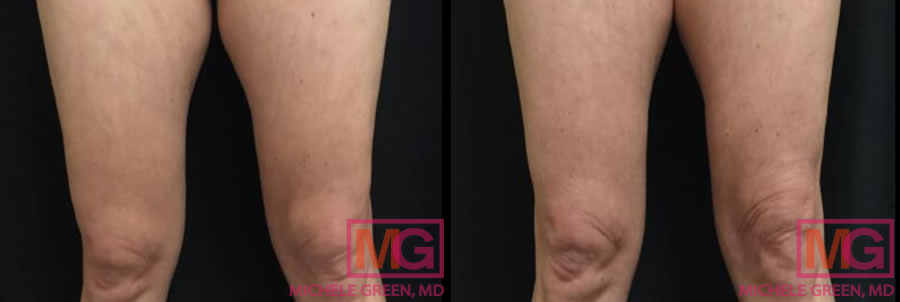Cellulite Treatment for Legs
Cellulite is a skin condition marked by dimples that give the skin a lumpy, “orange peel,” or “cottage cheese” texture. Although more common in women, cellulite can develop in anyone regardless of age, weight, or gender. It may appear on various parts of the body, including the abdomen, buttocks, arms, and legs. While cellulite is very common, it can make many people feel self-conscious. Fortunately, Dr. Green offers several non-invasive treatments for cellulite to help minimize the appearance of dimpling, so you can look and feel your best again.
The rippling skin effect associated with cellulite results from thickening and tightening of the connective tissue, which creates tension on the skin’s surface while pushing fat cells upward. Treatments like subcision with dermal fillers work to break apart the fibrous bands of connective tissue and restore volume in the dimpled areas. Laser treatments, such as Thermage FLX, stimulate collagen production to smooth, tighten, and firm the skin. With many options available, cellulite reduction can seem overwhelming, but Dr. Michele Green is here to help.
Dr. Green is an internationally renowned and board-certified cosmetic dermatologist with over twenty-five years of experience providing top cosmetic dermatology services to discerning men and women, including non-invasive cellulite treatments. She is frequently recognized as one of New York City’s top physicians by Super Doctors, New York Magazine, Castle Connolly, and The New York Times, thanks to her expertise and dedication. When you consult with Dr. Green at her private dermatology practice in Manhattan’s Upper East Side, she will work with you to develop a personalized treatment plan tailored to your skin type, concerns, tone, and aesthetic goals.
What is cellulite?
Cellulite is a skin condition that commonly affects areas of the body with high fat content, such as the legs and buttocks. It is characterized by dimpled and lumpy skin and is often called an “orange peel” or “cottage cheese-like” appearance.
There are four grades of cellulite:
- Grade 0 (no cellulite) – no visible cellulite on the body.
- Grade 1 (mild cellulite) – no visible cellulite while standing, but some dimpling when sitting.
- Grade 2 (moderate cellulite) – visible cellulite dimples appear on the skin both while standing and sitting.
- Grade 3 (severe cellulite) – severe cellulite dimples are always present, along with larger raised and depressed areas.
Cellulite can affect patients of any age, gender, or weight and may appear in various areas of the body. Most commonly, patients notice visible cellulite dimples or rippling on the arms, stomach, buttocks, and legs. Many advanced treatment options are available at Dr. Michele Green’s office, designed to address cellulite of any severity in all areas of the body. During your consultation at her private dermatology office on the Upper East Side of Manhattan, she will work with you to determine the best cosmetic treatment or combination of treatments to suit your needs.
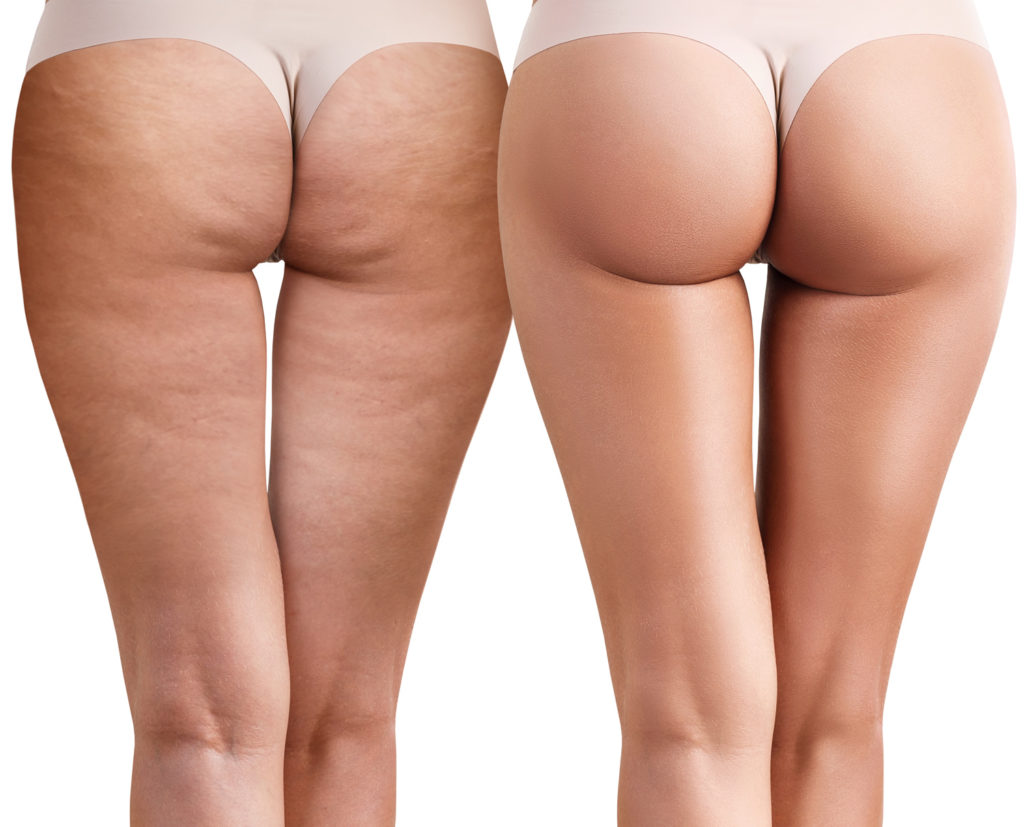
What causes cellulite on the legs?
Many people believe that cellulite results from an increase in the size or number of fat cells related to higher body weight and fat. Although it may influence how severe cellulite dimples appear on the skin, simply having more fat cells does not cause cellulite to form. Cellulite occurs when the fibrous bands in the skin, known as fibrous septae, start to thicken, and fat begins to accumulate in the area—this thickening process creates tension between the skin and the underlying muscle. As these fibrous bands tighten, they pull the skin downward, causing fat to bulge out and create a dimpled look. As we age, our skin produces less collagen, which leads to skin laxity. The loss of elasticity associated with aging can make cellulite more visible. Another factor that plays a role in cellulite development is the level and fluctuation of hormones within the body. Fluctuations in estrogen levels can cause existing fat cells to grow larger and increase the production of connective tissue, which is why women are much more likely to develop cellulite than men.
Is cellulite treatable?
Although cellulite cannot be completely eliminated, its appearance can be significantly diminished through non-invasive treatments. If you’re interested in cellulite reduction options, schedule a consultation with an expert, board-certified cosmetic dermatologist like Dr. Michele Green in New York City. During your visit, you can discuss your physical and aesthetic goals, explore treatment options that best address your concerns, and work towards achieving long-lasting results. Whether you’re treated with Thermage or a customized combination of cellulite therapies, Dr. Green will personalize your plan to suit your specific needs.
In-office procedures to treat cellulite on legs and thighs
Thermage laser treatment for cellulite reduction
Thermage is a non-invasive procedure that uses radiofrequency technology to tighten, smooth, and firm the skin. It is an excellent treatment option for patients seeking to improve the appearance of cellulite on the buttocks, thighs, and upper arms. The radiofrequency energy from Thermage penetrates the dermal layers to stimulate new collagen production and remodel existing collagen. Collagen, a natural structural protein, provides the skin with better elasticity, a firmer foundation, and a more youthful look. As we age, collagen production decreases, leading to skin laxity and more noticeable cellulite. By promoting collagen growth, Thermage can replenish lost collagen in targeted areas, resulting in tighter, smoother skin and a reduction in cellulite. Patients often see visible results immediately after a single session, and the device’s comfort pulse technology helps minimize discomfort during treatment. In addition to reducing cellulite, Thermage can also be used on the abdomen, face, jowls, and thighs to improve skin elasticity and promote a younger, more rejuvenated appearance.
Subcision with Sculptra dermal filler for cellulite dimples
Subcision is a minimally invasive cosmetic procedure that breaks up the fibrous bands responsible for the appearance of cellulite. During the procedure, a fine needle is used to disrupt the thickened fibrous bands, which reduces skin tension and diminishes the dimpling effect. Dr. Green often suggests combining subcision with Sculptra dermal fillers to target the fibrous bands while simultaneously restoring volume to the indented areas. Sculptra contains poly-L-lactic acid, which provides a supportive scaffold in the skin to stimulate new collagen growth. By restoring collagen in the treated area through Sculptra injections, patients can achieve smoother, firmer, and tighter skin, along with a decrease in visible cellulite. Since Sculptra treatment is gradual, multiple sessions spaced four weeks apart are needed to optimize collagen production and results.
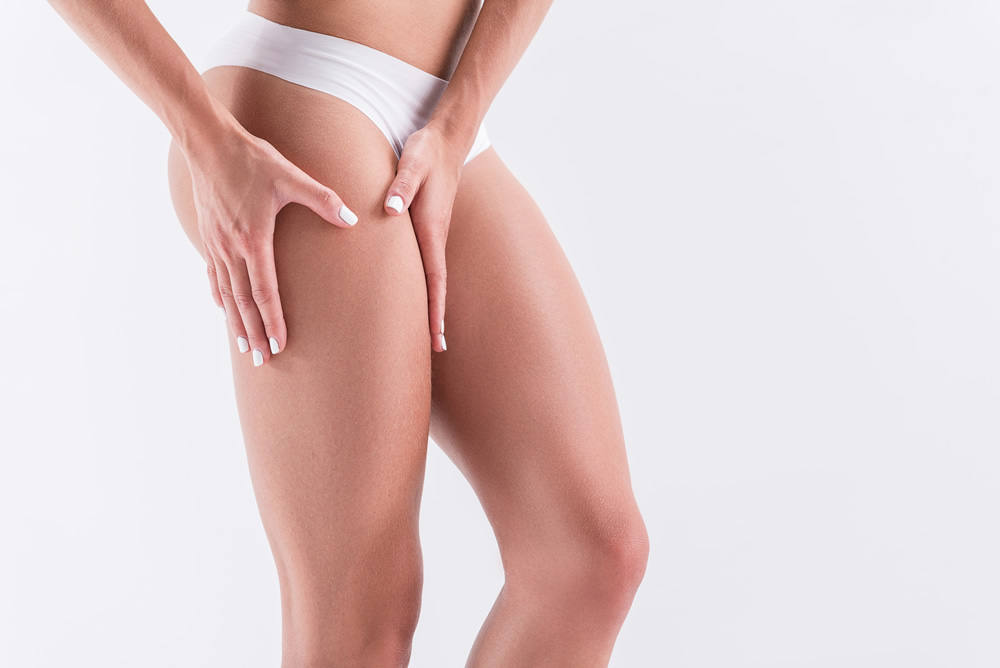
VelaShape treatment for the appearance of cellulite
VelaShape is an effective cellulite reduction treatment that uses radiofrequency (RF) energy, infrared (IR) light, and vacuum technology, combined with deep tissue massage, to reduce cellulite, promote lymphatic drainage, and shape the body. When the handpiece is pressed against the skin, it delivers RF energy and IR light, which heat the fat cells and the inner layer of skin to boost collagen production, resulting in smoother, firmer skin. The vacuum technology helps dissipate the buildup beneath the skin and loosens fibrous septae to contour the area. After 5-6 treatment sessions, each lasting less than an hour, you should start to see improvements in cellulite reduction from the treatments. There is no downtime afterward, so you can return to your usual daily activities immediately following the VelaShape procedure. VelaShape is particularly effective for reducing cellulite on the buttocks and thighs, as well as for overall body contouring and slimming of the thighs.
Cellfina cellulite treatment
Cellfina is a minimally invasive treatment for cellulite on the buttocks and thighs that targets the fibrous connective bands pulling on the skin, causing cellulite dimpling. It is an FDA-approved procedure that uses a microblade to break up and loosen these bands beneath the skin. By targeting the fibrous bands that cause dimpling and holding the skin taut, Cellfina improves the appearance of cellulite, making the skin look smoother and firmer.
Cellulaze to remove cellulite from the back of the thighs
Another treatment that targets the fibrous bands causing the appearance of cellulite is the Cellulaze procedure. This minimally invasive method involves inserting a laser fiber under the skin, which cuts the fibrous septae to release the tension between the muscles and the skin. Once this tension is released, the fat cells are redistributed, leading to smoother skin. Because the procedure involves a small incision, there is some downtime—typically 1 to 2 days after treatment—and the results can last up to a year.
Carboxy treatment to remove dimples on the thighs
Carboxy treatment is another minimally invasive cosmetic procedure that improves skin appearance by injecting carbon dioxide into the tissue beneath the skin. Carbon dioxide boosts circulation to the treatment area, which enhances collagen production and tissue regeneration. Another benefit of increased circulation is lymphatic drainage, helping remove excess fluid from fat cells and reducing the size of dimples. This leads to smoother, tighter skin and ultimately less visible cellulite. Depending on the severity of the cellulite, patients may need multiple treatment sessions to achieve the best results.
Mesotherapy to treat cellulite
Mesotherapy is a minimally invasive treatment for cellulite reduction that targets fat cells and encourages lymphatic drainage. The procedure involves injecting proteins and enzymes into the middle layer of the dermis. These proteins and enzymes help break down fat cells to reduce cellulite in the treated area. Patients often need multiple sessions to achieve the best results. Mesotherapy can be more effective when combined with a procedure that also targets the fibrous septae, such as Cellfina.
Acoustic Wave Therapy to remove cellulite
Acoustic wave therapy is a non-invasive treatment that reduces inflammation through tissue vibrations, stimulating collagen production. The sound waves cause the skin and underlying connective tissue to vibrate, improving circulation and increasing collagen synthesis. The vibrations also promote the breakdown of excess fat cells and enhance lymphatic drainage, resulting in smoother, firmer skin. This procedure requires no downtime, and patients can expect optimal results after 8-10 sessions.
What skincare products are best for getting rid of cellulite?
When cellulite dimples or rippling begin to appear on parts of the body such as the arms, legs, or buttocks, many patients may first try to reduce their appearance with topical cellulite creams. Various lotions can help ease the symptoms of grade 1 cellulite and can be added to your skincare routine. There are two main types of cellulite creams: those made with retinol and those made with caffeine.
Retinols are an over-the-counter vitamin A derivative that can encourage thicker skin and lessen the look of cellulite. They also boost skin turnover and the creation of new, healthy skin cells. Retinol creams work slowly to stimulate collagen production, and it may take several months to see any improvement in mild cellulite. Caffeine-based creams are especially good at increasing circulation in the applied area, plumping the skin, and helping to lessen the visible signs of cellulite.
Other ingredients in cellulite creams include cocoa butter and shea butter. Cocoa butter cream is good at moisturizing the skin, while shea butter can help make skin smoother and firmer. However, their effectiveness in reducing cellulite has not been proven. Creams by themselves usually do not give the results people want for cellulite reduction. It’s always best to consult an experienced healthcare provider, like board-certified dermatologist Dr. Michele Green, who offers innovative treatments to effectively improve cellulite.
How to get rid of cellulite naturally at home
Dry brushing is a popular home remedy believed to help reduce the appearance of cellulite. It involves using a stiff-bristled brush on the skin in long, sweeping strokes or circular motions to promote blood flow, improve circulation, temporarily plump the skin, and diminish cellulite. Although some may see short-term improvements in cellulite’s appearance, there is no evidence that dry brushing provides a long-term solution.
What is the best treatment for cellulite on your legs?
With so many treatment options available, patients naturally want to choose the best treatment to eliminate their cellulite. No single treatment is “best” for treating cellulite on the legs – it’s important to find the option that aligns with your aesthetic and physical goals and is both safe and effective for your body contour. The most effective approach may involve a combination of different cosmetic treatments, such as Thermage and Sculptra injections. During your initial consultation with Dr. Green, she will discuss your treatment options and desired cosmetic results to develop a personalized plan focused on reducing cellulite on your legs.
Will cellulite go away?
Unfortunately, cellulite won’t disappear without treatment. While some lifestyle adjustments can help reduce cellulite by lowering fat buildup, such as eating a healthy, balanced diet and exercising regularly, these alone are not enough to eliminate cellulite. The fibrous bands attaching the skin to the underlying muscle won’t soften or stretch when the fat cells shrink. Cellulite creams can temporarily improve the appearance of cellulite by hydrating and plumping the skin. However, they are not permanent or long-term solutions, and they are ineffective for more severe cellulite. The most effective treatments for cellulite reduction are non-invasive options, like Thermage and subcision with Sculptra injections, which can help smooth the skin, break apart fibrous tissue bands, and restore volume in dimples. If you want smoother, firmer skin on your legs and want to reduce cellulite, consult a board-certified dermatologist, such as Dr. Green in NYC, who can create a personalized cellulite treatment plan tailored to your goals.
FAQs about Cellulite Treatments:
Why are my legs getting so much cellulite?
Generally, cellulite forms when fat pushes through the skin, which is kept tight by tough, fibrous bands called septae. This creates an uneven surface, making the skin appear dimpled and lumpy. Common areas where cellulite develops include the thighs, buttocks, hips, and abdomen. Factors like genetics, sex, and age can increase the chances of developing cellulite on the legs. However, anyone regardless of age, gender, or size can get cellulite. Cellulite often runs in families, so if your mother has it, you’re more likely to develop it too. Women are more prone to cellulite than men. According to the American Academy of Dermatology (AAD), cellulite affects 80-90% of women in the U.S. Women naturally store more fat in the buttocks and thighs, and there are differences in muscle and connective tissue distribution. As we age, collagen production slows down, leading to looser skin, which can make cellulite more noticeable as the skin wrinkles and folds over the dimples. If cellulite on your legs bothers you, there are non-invasive treatments available at Dr. Green’s office in the Upper East Side that can help reduce its appearance.
Can weight loss reduce the appearance of cellulite?
Many people recommend exercise and a healthy, processed-food-free diet to promote weight loss and build muscle. While these lifestyle choices can help you feel better and may slightly reduce the appearance of cellulite, they do not guarantee the elimination of dimples and rippling caused by genetics, and the process can be slow. Additionally, weight loss may lead to skin laxity or loose skin, which can make cellulite look worse as the skin wrinkles and folds over the dimples. If you want to get rid of cellulite on the buttocks and thighs quickly and effectively, various non-invasive treatments are available. Dr. Green stays at the forefront of cosmetic dermatology, using radiofrequency technology, laser treatments, and topical supplements to effectively address cellulite.
How to get rid of side leg cellulite
One of the most common body areas where people notice cellulite is on the legs, especially the thighs, which are more prone to fat build-up. To target specific areas of your legs with cellulite, a treatment plan that combines different procedures can be used to significantly reduce visible cellulite. Non-invasive options are available, including radiofrequency treatments, laser therapies, and Sculptra injections, which address common causes of cellulite such as skin laxity, fibrous bands, and dimpling. Dr. Michele Green, a board-certified dermatologist, will develop a personalized cellulite treatment plan tailored to help you achieve smoother, firmer skin.
How to prevent cellulite on the thighs
Many believe cellulite forms solely due to body fat and that healthy eating and regular exercise can prevent it. However, because of various biological factors involved in cellulite development, it isn’t as easy to prevent the dimpling and rippling as some think. While exercise can help build muscle and tone the buttocks and legs, potentially reducing the appearance of cellulite, it is often not enough to completely eliminate the risk. Several other factors also contribute to cellulite that can’t be prevented by diet and exercise alone. Cellulite can result from the natural aging process, especially in women, due to hormonal changes that happen over time. Genetics also play a significant role in its development. Although preventing cellulite entirely may not be possible, various treatments are available to reduce its appearance once it has formed.
How to cure cellulite on legs
Unfortunately, cellulite is not “curable.” However, its appearance can be significantly reduced with non-invasive procedures, including radiofrequency treatments such as Thermage and Velashape, subcision with Sculptra dermal filler, laser treatments like Cellulaze, and Cellfina treatment. Topical cellulite creams can help soften and tighten the skin by increasing blood flow and providing moisture to plump the skin, temporarily improving skin laxity and offering short-term relief from cellulite. Expert, board-certified dermatologist Dr. Michele Green in NYC will help you navigate the wide array of cellulite reduction treatments and create a customized anti-cellulite treatment plan that will work best for you.
Do cellulite treatments actually work?
Yes! Cellulite treatments can effectively reduce the appearance of cellulite on the legs and arms. Qwo was the first injectable treatment that was FDA-approved in 2002 for cellulite reduction. Although Qwo has been withdrawn from the market due to unwanted side effects like prolonged bruising and discoloration, many other non-invasive options are available for cellulite reduction. Thermage FLX, the latest Thermage radiofrequency device, heats the dermal layers of the skin to stimulate collagen production, which helps smooth the skin and minimize cellulite. Subcision with Sculptra filler injections is highly effective at cutting the fibrous bands and plumping the skin to decrease cellulite dimples. Additional treatments, such as Velashape, Cellulaze, and Cellfina, work to break apart the fibrous bands that pull on the skin and cause cellulite. For optimal results, patients often combine multiple treatment approaches. If you’re ready to improve the appearance of your cellulite, schedule a consultation with Dr. Michele Green in NYC to find the best treatment plan for you.
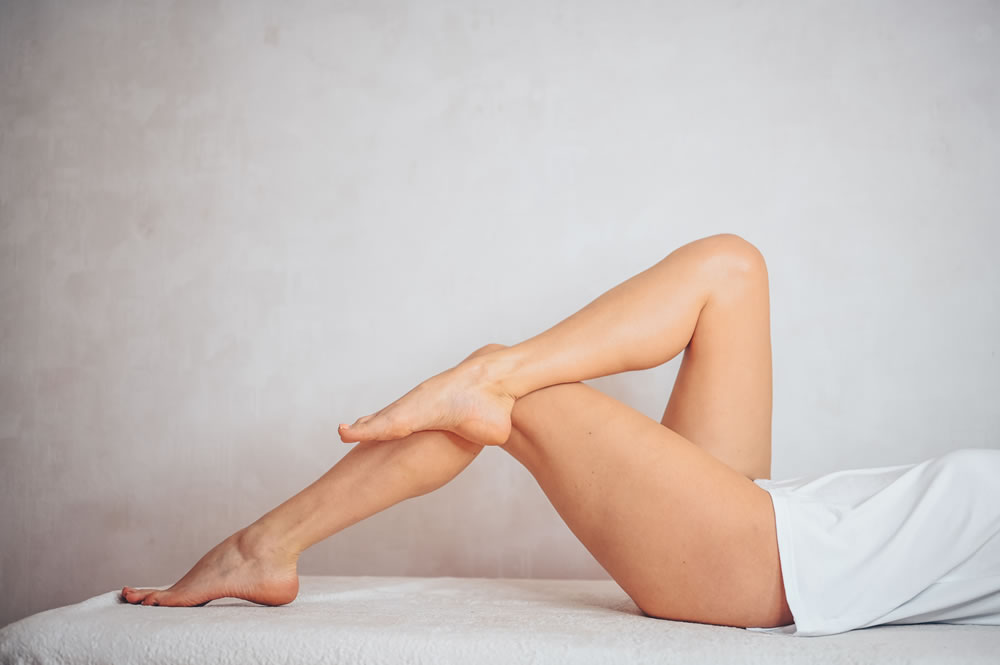
Is liposuction effective for cellulite reduction?
Liposuction is a cosmetic procedure performed by a plastic surgeon where excess fat is removed from a specific area of the body. During the procedure, a metal rod is inserted through an incision to extract the excess fat. Because of the invasive nature of this surgery, liposuction involves a significant recovery period and a higher risk of side effects. While liposuction effectively removes fat cells, it does not address the fibrous bands responsible for the appearance of cellulite. As a result, liposuction alone often cannot fully treat cellulite, and additional procedures are usually needed to eliminate it. In many cases, performing liposuction without other cellulite reduction treatments can even worsen the appearance of cellulite on the skin.
How to remove cellulite from legs naturally?
While there are ways to reduce the appearance of cellulite naturally and without cosmetic procedures, these methods will not fully eliminate cellulite and may not yield significant results. Some lifestyle changes patients make to lessen their cellulite include eating a healthy diet and exercising regularly. These activities help prevent excess fat buildup and strengthen the muscles. Other activities, such as dry brushing, can temporarily boost blood flow, which helps tighten the skin and diminish the look of cellulite. However, these approaches are not effective for long-term cellulite reduction.
What leg exercises get rid of cellulite?
Engaging in physical activity and leg exercises can help build muscle and reduce fat, potentially making your skin firmer and decreasing the appearance of cellulite. Reducing fat can lead to fewer fat cells pressing against the skin, resulting in less unevenness and dimpling. However, you may develop loose skin as a result of weight loss, which can make cellulite more noticeable. Weight loss alone may have a limited effect on reducing cellulite since the condition mainly arises from biological factors that influence the fibrous bands connecting your skin to your muscle. It’s important to remember that cellulite can occur in individuals regardless of their leanness. Effective reduction or removal of cellulite typically requires dermatological treatments. Consult with board-certified dermatologist Dr. Michele Green to create a personalized cellulite treatment plan that effectively targets your cellulite for lasting results.
Will lunges improve cellulite?
Lunges and other exercises, such as squats, can help reduce the appearance of cellulite; however, they are not sufficient to eliminate it. Regular exercise and strength training can help to minimize the appearance of cellulite by reducing body fat percentage. However, exercise is not enough to eliminate cellulite due to the numerous underlying biological factors. Exercise is an important part of any lifestyle and is always beneficial for health and wellness.
How long does it take to tone legs and get rid of cellulite?
Lifestyle changes can be used to tone the legs and reduce fat, but ultimately they cannot target the fibrous bands that are largely responsible for the appearance of cellulite. With various dermatological treatments that break up connective tissue under the skin responsible for cellulite, noticeable cellulite reduction results can be seen within weeks, with lasting effects. When you consult with Dr. Green, she will work with you to create an effective cellulite treatment plan that combines non-invasive techniques tailored to your specific cosmetic goals.
How to smooth out cellulite on thighs?
Cellulite has a noticeably dimpled, uneven appearance on the skin and is often described as having an “orange peel” or “cottage cheese” texture. It develops when tension exists between the connective tissue and fat cells underneath the skin. The connective tissue pulls the skin down while the fat cells push up, creating the lumpy skin texture characteristic of cellulite. Various dermatological treatments, such as Thermage, can help smooth the appearance of cellulite on your thighs by stimulating collagen production, which results in tighter, firmer skin. Dermal fillers can also be used together to stimulate collagen and fill in depressions, leading to a smoother look. To learn more about how to get rid of “cottage cheese thighs,” consult a board-certified dermatologist like Dr. Michele Green in NYC to explore the most effective treatment options for targeting cellulite.
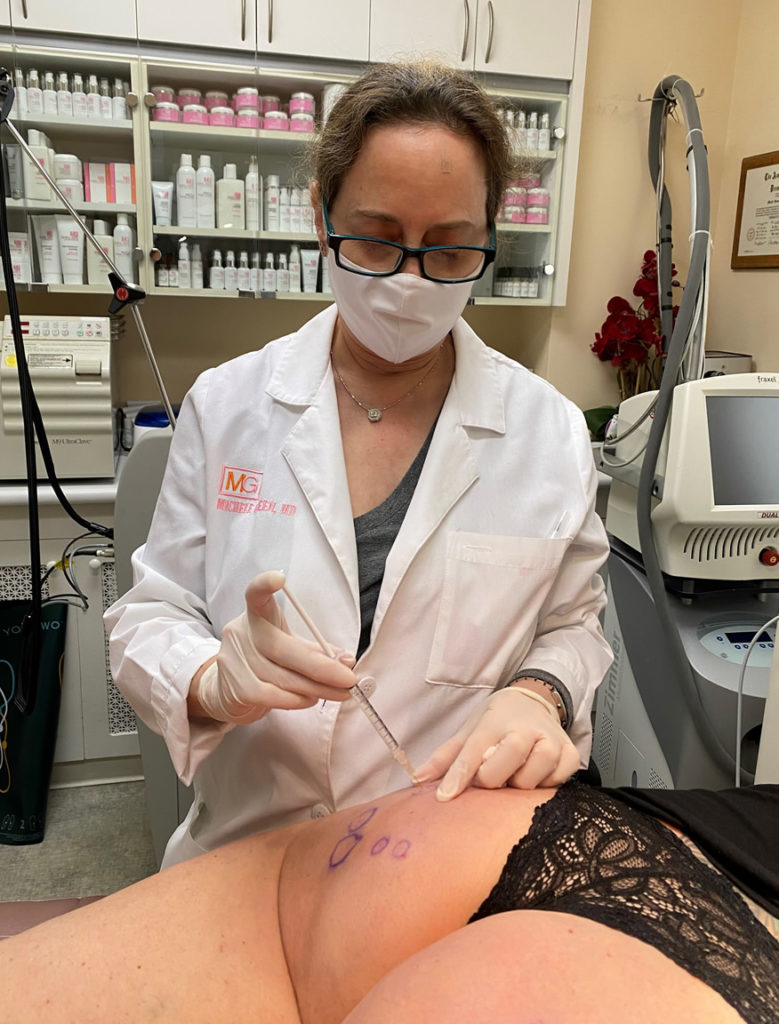
How do I get started with cellulite treatment?
Cellulite is a common skin condition that can affect anyone, regardless of their weight, age, or gender. While many people are affected by cellulite, the appearance of dimples and rippling on the arms, legs, and buttocks can lead to feelings of self-consciousness. Fortunately, there are several treatment options available, such as Thermage radiofrequency and Sculptra dermal filler injections. These non-invasive procedures can help smooth the skin and diminish the appearance of dimpling with little to no downtime, making them excellent choices for cellulite reduction. If you’re frustrated with the look of cellulite and want an effective, long-lasting solution for uneven skin texture, Dr. Green in New York City is here to help.
Board-certified dermatologist Dr. Michele Green has over 25 years of experience providing her patients with personalized treatment plans that include the best non-invasive procedures, such as body contouring, cosmetic injectables, and resurfacing laser treatments. Her commitment to her patients is evident in the fact that she is consistently recognized as one of New York City’s top dermatologists by Castle Connolly, Super Doctors, New York Magazine, and The New York Times. Dr. Green adopts a holistic approach to cosmetic dermatology, tailoring each patient’s treatment plan to their specific skin concerns and aesthetic goals. If you’re dealing with the appearance of cellulite dimples, schedule a consultation with Dr. Michele Green in NYC by contacting us online or by calling the office at 212-535-3088 to learn more about how to get rid of cellulite on the thighs.
 212-535-3088
212-535-3088 